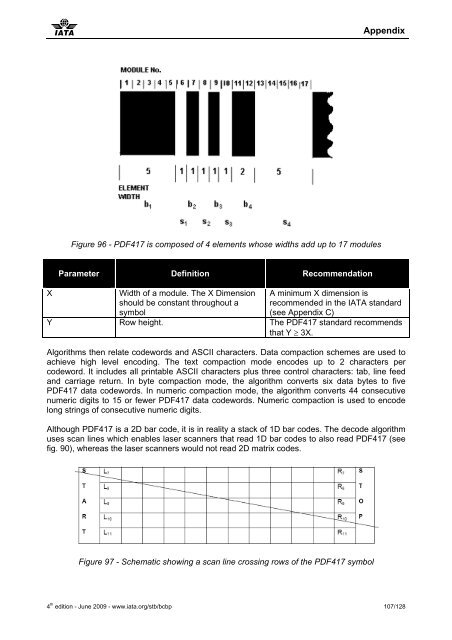Bar-Coded Boarding Passes (BCBP) Implementation guide - IATA
Bar-Coded Boarding Passes (BCBP) Implementation guide - IATA
Bar-Coded Boarding Passes (BCBP) Implementation guide - IATA
You also want an ePaper? Increase the reach of your titles
YUMPU automatically turns print PDFs into web optimized ePapers that Google loves.
Appendix<br />
Figure 96 - PDF417 is composed of 4 elements whose widths add up to 17 modules<br />
X<br />
Parameter Definition Recommendation<br />
Width of a module. The X Dimension<br />
should be constant throughout a<br />
symbol<br />
A minimum X dimension is<br />
recommended in the <strong>IATA</strong> standard<br />
(see Appendix C)<br />
Y Row height. The PDF417 standard recommends<br />
that Y ≥ 3X.<br />
Algorithms then relate codewords and ASCII characters. Data compaction schemes are used to<br />
achieve high level encoding. The text compaction mode encodes up to 2 characters per<br />
codeword. It includes all printable ASCII characters plus three control characters: tab, line feed<br />
and carriage return. In byte compaction mode, the algorithm converts six data bytes to five<br />
PDF417 data codewords. In numeric compaction mode, the algorithm converts 44 consecutive<br />
numeric digits to 15 or fewer PDF417 data codewords. Numeric compaction is used to encode<br />
long strings of consecutive numeric digits.<br />
Although PDF417 is a 2D bar code, it is in reality a stack of 1D bar codes. The decode algorithm<br />
uses scan lines which enables laser scanners that read 1D bar codes to also read PDF417 (see<br />
fig. 90), whereas the laser scanners would not read 2D matrix codes.<br />
Figure 97 - Schematic showing a scan line crossing rows of the PDF417 symbol<br />
4 th edition - June 2009 - www.iata.org/stb/bcbp 107/128
















